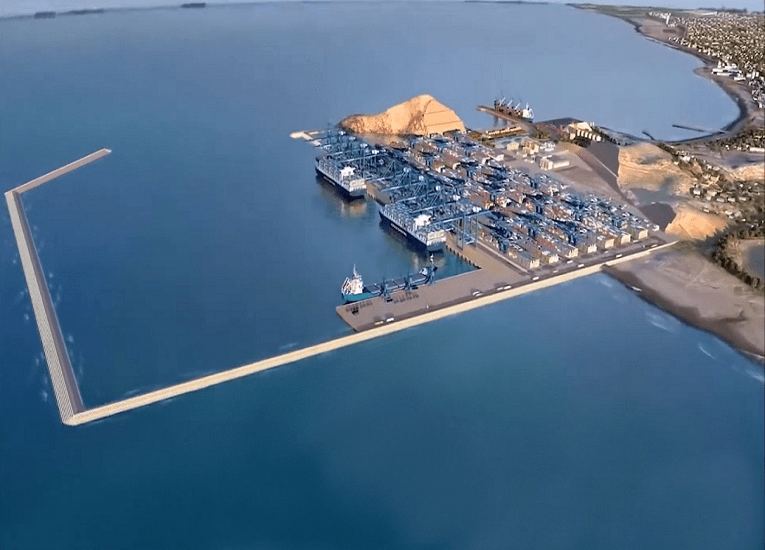
The Chancay Megaport, an ambitious project located on the northern coast of Lima, is destined to become a milestone in maritime trade between Asia and Latin America. With an opening date scheduled for November 2024, this infrastructure promises to transform the logistics landscape of the region, positioning itself as a direct competitor to the main Chilean ports, San Antonio and Valparaíso. The impact of this new megaport will not only be limited to the flow of goods, but could also have profound economic implications in both Peru and Chile.
The construction of the port is led by Cosco Shipping, one of the largest shipping companies in the world, which already gives it significant support in terms of financial capacity and experience. The strategic location of Chancay, in the center of the Pacific coast, makes it a key point for the trade routes that link Asia with South America, especially with the Peruvian market and other countries in the region. It is expected that the infrastructure will allow the docking of large ships, which would give companies the possibility of optimizing their logistics costs and reducing times in the supply chain, benefiting both exporters and importers.
On the other hand, in Chile, this advance has generated concern in the economic sphere. The ports of San Antonio and Valparaíso, which for years have been references for maritime trade in the South Pacific, could see their activity affected due to the entry into operation of the Chancay Megaport. Both Chilean ports are located in the central region of the country, and although they have managed to consolidate themselves as nerve centers of international trade, they face significant limitations in their capacity for expansion. These restrictions, mainly of a geographical and urban nature, have been the subject of debate among experts who see the Peruvian port as a serious threat to the leadership that they have exercised until now in the region.
One of the experts who has expressed concern about this situation is Caupolicán Guerra, a Chilean academic and logistics specialist. According to Guerra, the port of San Antonio, despite its strategic location, faces growth limitations due to its proximity to urban areas. The port of Valparaíso is in a similar situation, which has also had difficulties expanding its infrastructure, which complicates the modernization necessary to remain competitive in the face of the development of Chancay. In this context, the new Peruvian port could capture a significant portion of the merchandise traffic that currently transits through Chile, directly affecting the Chilean economy.
Cosco Shipping celebrates a new milestone in the construction of the Port of Chancay
Luis Knaak, general manager of the Port of San Antonio, has also expressed concern regarding Chile’s ability to quickly adapt to the changes that international trade will impose. According to Knaak, the greatest threat lies in logistics companies choosing to divert their cargoes to Chancay, which would not only affect the direct income of Chilean ports, but would also have repercussions on the country’s entire logistics chain. An increase in transportation costs and a reduction in competitiveness are two of the most serious risks Chile faces if it fails to respond effectively to this new competition.
Despite these warnings, various strategies have been proposed in Chile to mitigate the impact that the Chancay Megaport could have. One of the main proposals is the modernization and expansion of the ports of San Antonio and Valparaíso, with the aim of increasing their capacity to handle greater volumes of cargo and optimize operation times. However, these plans have faced significant obstacles, including environmental and political restrictions that have delayed the execution of expansion projects. In the event that the Peruvian port manages to quickly consolidate itself as a key node in trade between Asia and Latin America, Chilean ports could be at a disadvantage.
International trade in Latin America is at a crossroads before the imminent entry into operation of the Chancay Megaport. Traditional trade routes, which have favored Chilean ports such as San Antonio and Valparaíso, could be re-evaluated by large shipping companies seeking efficiency and lower operating costs. Although the total impact that this infrastructure will have on the region is still uncertain, the truth is that it represents a significant challenge for Chile’s economic actors.
The ability of both countries to adapt to this new scenario will be crucial in the coming years. While Peru is committed to strengthening its position as a key logistics center in the Pacific, Chile must find quick and effective solutions to modernize its port infrastructure and ensure its competitiveness in the international market. In this sense, the Chancay Megaport symbolizes much more than a work of engineering: it represents a change in the dynamics of commercial power in South America, with implications that could redefine relations between Asia and Latin America.
Source: https://reporteasia.com/negocios/2024/10/08/chancay-vs-puertos-chilenos-la-nueva-competencia-en-el-comercio-maritimo-de-sudamerica/

